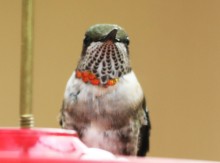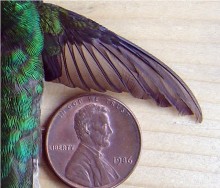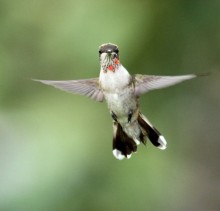Before migration, hummingbirds feed intensely. Scientists call the pre-migration feeding frenzy hyperphagia. The tiny birds spend more time than usual lapping up nectar and eating insects. For birds about to migrate, food means survival.
With your test gardens, you can contribute scientific information by monitoring connections between plant growth and climate. What discoveries will be made from the data collected by Journey North citizen scientists?
When Shimmer? When Not?
When you look at an animal, it's usually easy to tell what color it is, but hummingbirds can fool us! Sometimes the hummer's throat feathers, called the gorget, shimmers with color. But other times it looks dark.
For a long time, scientists didn't know what made the gorgets of many male hummingbirds seem to change. But now they have an idea, thanks to special microscopes that allowed them to take a closer look at the feather structures.
Observing Fall Behavior
As summer ends and autumn nears, hummingbirds respond to seasonal changes: shorter daylight, cooler temperatures, and fall blooms. They instinctively know when to leave their breeding grounds. Fewer hours of daylight trigger hormonal changes that cause the urge to fuel up and fly south even though nectar-rich flowers are still in bloom and sugar-water feeders are full. What behaviors will you see this fall?
Report your observations as hummingbirds migrate from your backyard to their wintering grounds.






